INDIAN ARMED FORCES CHIEFS ON OUR RELENTLESS AND FOCUSED PUBLISHING EFFORTS

The insightful articles, inspiring narrations and analytical perspectives presented by the Editorial Team, establish an alluring connect with the reader. My compliments and best wishes to SP Guide Publications.

"Over the past 60 years, the growth of SP Guide Publications has mirrored the rising stature of Indian Navy. Its well-researched and informative magazines on Defence and Aerospace sector have served to shape an educated opinion of our military personnel, policy makers and the public alike. I wish SP's Publication team continued success, fair winds and following seas in all future endeavour!"

Since, its inception in 1964, SP Guide Publications has consistently demonstrated commitment to high-quality journalism in the aerospace and defence sectors, earning a well-deserved reputation as Asia's largest media house in this domain. I wish SP Guide Publications continued success in its pursuit of excellence.
- The layered Air Defence systems that worked superbly, the key element of Operation Sindoor
- Operation Sindoor | Day 2 DGMOs Briefing
- Operation Sindoor: Resolute yet Restrained
- India's Operation Sindoor Sends a Clear Message to Terror and the World – ‘ZERO TOLERANCE’
- Japan and India set forth a defence cooperation consultancy framework, talks on tank and jet engines
EXCLUSIVE
“Shortage in the number of fighter squadrons is being addressed through multipronged approaches”
In an exclusive interview to Jayant Baranwal, Editor-in-Chief, SP’s Aviation on the occasion of Aero India 2023, Air Chief Marshal V.R. Chaudhari, Chief of the Air Staff, gave some very elaborate and candid insights on the plans and preparedness of the Indian Air Force
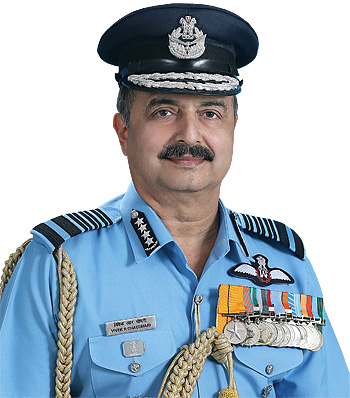
SP’s Aviation (SP’s): Electronic Warfare (EW)
(a): What capabilities IAF should be possessing in view of the perceived threat scenarios?
Chief of the Air Staff (CAS): EW systems endow an enhanced layer of protection to weapon platforms, while also denuding the adversary aircraft of the same. Consequently, there is a need to equip all aircraft with EW self-protection systems like Radar Warning Receivers, Airborne Self Protection Jammers (ASPJs), Missile approach and warning systems and Laser Warning Systems. Whilst some transport and helicopters do possess some capability, there are others which need to be provided with additional protection. Such self-protection measures also need to be complimented with an offensive EW capability. This could be in the form of a transport aircraft jamming from stand-off distances or light weight jammers on Remotely piloted aircraft (RPA). Other avenues that we are looking at include high power Directed Energy Weapons and multipurpose ground based jammers.
(b): And how do you perceive the current state of affairs?
CAS: The IAF has equipment of diverse origins, thus having varying philosophies of employment. This has given us an interesting insight into the employment of Electromagnetic Counter Measure techniques by different countries. By now we are also very familiar with the EW methodologies and systems operated by our adversaries. We have thus been able to refine our techniques and develop cogent responses. Work is in progress to equip our platforms with the latest EW systems, while existing deficiencies are being addressed in tandem. But this is a cat & mouse game, wherein continuous refinements are necessitated and that is what we endeavour to do.
SP’s: Please enlighten us in terms of the IT-based protection capabilities if you are duly satisfied with the current level of systems in place.
CAS: As the IAF’s operations become more netcentric and our offices more paperless, there is a need for us to enhance the protection of our IT assets. We have therefore undertaken a slew of measures in this regard. For instance, multi-layered security solutions and security management systems are now in place to defend our Net Centric Warfare infrastructure. A dedicated Security Operation Centre (SOC) has also been setup with a dedicated Security Information and Event Management System where real time threats are monitored. The Computer Emergency Response Team of the IAF in turn, responds to these threats. A separate Internet Security Operation Centre (iSOC) has also been setup for ensuring the security of our internet machines. A dedicated Air Force Cyber Group oversees these functions, while air warriors are trained in our Information Warfare School which has been setup to enhance cyber education and cyber security awareness among our personnel.
“The IAF plans to induct six squadrons of the Multi-Role Fighter Aircraft (MRFA) in a phased manner. The necessity of ‘Make in India’ has been conveyed to all the OEMs.”
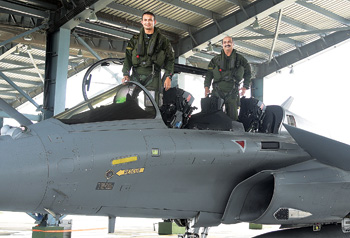
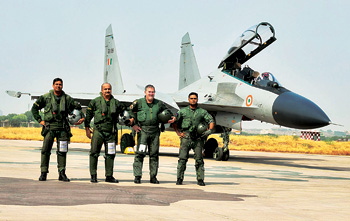
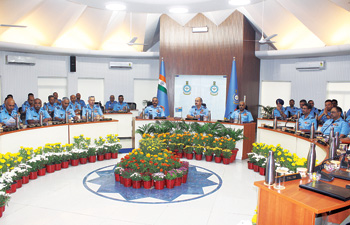
SP’s: Countering Cyberattacks. Would you like to share what sort of eventualities/threat scenarios need to be kept in mind while planning and executing the necessary firewalls enabling fool-proof solutions?
CAS: Key to our Cyber security is redundancy and defensive depth that adopts a layered approach to protect our data and information. Our endeavour is that in case of failure of one mechanism, another should stepin immediately to foil an attack. This multi-layered approach enhances the security of our systems as a whole and is able to thwart different attack vectors. However, we have to be very nimble, adaptive and flexible by continually upgrading our infrastructure and procedures. We have to thus employ a combination of security products such as next generation firewalls, network segmentation, malware scanners, endpoint security, Patch management etc.
SP’s: Multi-Role Fighter Aircraft (MRFA)
(a): When will this programme finalise?
CAS: The IAF plans to induct six squadrons of the MRFA in a phased manner. IAF is evaluating the responses to the RFI and Air Staff Qualitative Requirements for the proposal are being finalised prior to seeking Government approval. Certain key areas which need more elaboration are being queried, following which, necessary details would be included in ASQRs. The necessity of ‘Make in India’ has been conveyed to all the OEMs.
(b): What is the ratio of off-the-shelf delivery and manufacturing within India?
CAS: Towards reducing our foreign dependencies, the IAF is planning to minimise off the shelf deliveries while maximising manufacturing within India. The programme will also ensure long term maintenance support by Indian resources. The exact details can only be worked out as a part of contract negotiations.
SP’s: Fighter Squadrons
(a): We do believe Rafale has added great edge to the combatreadiness as the delivery of 36 French jets have been concluded and timely so.
CAS: Answer inclusive in the following response.
(b): In spite of the above, you have very candidly maintained that even by around 2035 the total number of squadrons will be well below the authorised and sanctioned level of 42 fighter squadrons for the Indian Air Force. Does this concern you?
CAS: There is no doubt that the Rafale is a very potent platform that has given a fillip to our combat preparedness. But we have to keep an eye on the larger picture as well. The IAF currently has 31 fighter aircraft squadrons. In the next 10 years, the squadrons operating the MiG-21 aircraft will be phased out completely alongwith some squadrons of MiG-29 and Jaguar aircraft. However, the shortfall would be offset by induction of the indigenously manufactured Light Combat Aircraft (LCA) Mk-1A fighter aircraft. Right now, the IAF is fully capable of undertaking its role of defence of the nation while future concerns are being looked after by current and future acquisitions.
(c): Is there any plan to arrest the depleting number of Fighter Squadrons? Can you kindly share the same?
CAS: The IAF has strived to arrest the draw-down of its fighter fleet and presently we are in the process of gradually building it up to the approved level of 42 squadrons. The shortage in the number of fighter squadrons is being addressed through multipronged approaches to ensure that this is realised within time, budget and under the ‘Make in India’ initiative.
“We are progressing the case for procuring six flight refuelling aircraft (FRA)”
The numbers of the indigenously manufactured fighter aircraft are only going to increase with the procurement of 83 LCA Mk1A, for which the contract has been signed with HAL on January 25, 2021. Deliveries are envisaged from January 2024 to January 2029. DRDO is working towards the indigenous development of LCA Mk2 and a fifth generation fighter aircraft, AMCA. Induction of the AMCA is expected to commence from 2035. IAF also plans to induct the Multi Role Fighter Aircraft (MRFA) in a phased manner. The programme is being progressed under ‘Make in India’ provisions of DAP-2020.
SP’s: Transport Fleet
(a): Can you kindly share your perspective of current fleet of military transport?
CAS: The IAF transport fleet is the fourth largest in the world. It comprises of a mixed bag of aerial assets ranging from VHETAC category (C-17) to LTA (Avro & Do-228). Each aircraft type in the transport fleet possesses a unique role and has proven its mettle on numerous occasions. The nation has been witness to the fleets’ contribution during several International evacuations, civil heavy lifts, HADR and SAR of troops and population at border areas. The potential of the IAF’s mobilisation capability was a major highlight during the Eastern Ladakh contingency. The fleet is undergoing further enhancement including the induction of the C295 aircraft which has a major ‘Make in India’ component.
(b): Is there any wish-list you may like to share with us?
CAS: As the An-32 and IL-76 legacy fleets are approaching EOL (End of Life), IAF is in the process of identifying suitable replacements. The demand for Air to Air refueling aircraft as force multipliers towards strengthening our fighting potential remains and we are therefore progressing the case for procuring six flight refuelling aircraft (FRA). As this process is likely to take some time, a case for leasing one FRA to augment the training requirements has also been initiated. Furthermore, we are also progressing a case for the induction of additional Dornier aircraft and upgrading some of our Dorniers through HAL. As part of the indigenisation process, we are also hopeful that MRO facilities for most of our platforms are established in India itself. We also look forward to early induction of AEW&C Mk II.
“The IAF transport fleet is the fourth largest in the world”
SP’s: Rotary Wing Fleet
(a): How about the combat readiness of IAF’s helicopters’ fleet?
CAS: Indian Air Force operates a variety of helicopters from the legacy Chetak/Cheetah to the Heavy Lift Chinook, from communication to attack platforms and from old generation to modern helicopters. The IAF helicopter capability has increased manifold in the past one decade with the induction of state of art helicopters like Mi-17V5, Chinook, ALH MKIV, Apache and latest Light Combat Helicopter. All these platforms have multi-role capability and are equipped with the latest avionics, weapons and other role equipment required to undertake the allotted tasks. The successful employment of these platforms in Eastern Ladakh bears testimony to their capability and versatility. Additionally, our helicopter fleet has always been at the forefront of all national tasks, aid to civil authorities and for providing vital support for infrastructure development in remote and border areas.
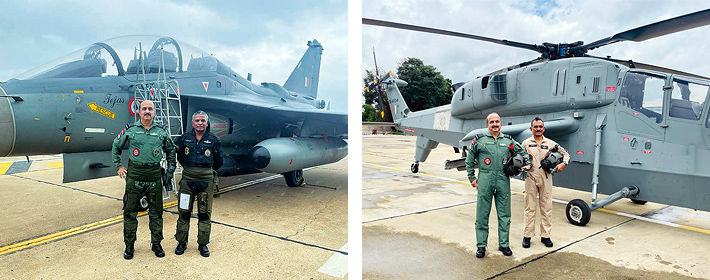
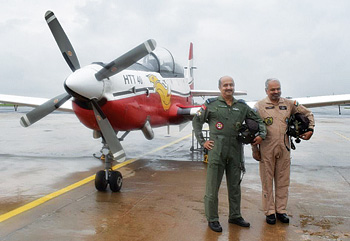
(b): Will be nice if you can kindly share any futuristic plans?
CAS: Recently, we have signed a contract for procurement of 10 Light Combat Helicopters (LCH) in the Limited Series Production version wherein four helicopters have already been inducted in October 2022. We plan to acquire more than 50 LCH in the near future. Likewise, procurement of Light Utility Helicopter (LUH) is also being progressed as a replacement for the Chetak/Cheetah helicopters. In the longer term, we would be keen to acquire the Indian Multi-Role Helicopter (MRH) which would be designed and developed indigenously. The design and development (D&D) is likely to take six to eight years and would cater for future MRH requirements of the IAF. Induction of IMRH is likely to commence from 2032 if there is no delay in the D&D.
SP’s: How do you perceive the evolving roles of unmanned versus manned platforms?
CAS: If you recollect an answer, I gave to a question at our annual press conference, prior to Air Force Day in October; I had said quite clearly, that ‘The Future is Unmanned’. The air domain was the first sphere where the unmanned aircraft had proliferated. This is primarily due to a larger line of sight distance which permits long ranged remotely controlled operations. But, as over the horizon links become common and machine autonomy increases, we will see a boom across all domains. In fact we are already seeing it on land and sea as well.
“I am very proud that the IAF has facilitated the development of a genuine swarming capability through our Mehar Baba Swarm Drone challenge”
Our study of recent conflicts has thrown up certain limitations of such aircraft in a contested airspace. Therefore, in the near term, there may be instances where it may not be prudent to deploy unmanned systems & others where they would be the platform of choice. Further down the line, we are likely to see systems that are designed as ‘optionally manned’ from the word go. More collaboration between manned and unmanned systems is also on the anvil. The IAF is also pursuing a similar project with HAL which is progressing quite well.
SP’s: Self-reliant Aerospace and Defence industry
(a): How do you perceive the R&D efforts being made in the country as this remains the foundation of achieving self-reliance towards the most crucial and the most non-compromising industry-the aerospace and defence industry.
CAS: IAF has always supported the national vision of ‘Atmanirbhar Bharat’ and IAF was at the forefront of indigenisation efforts. In the last few years, IAF has inducted various aircraft, radars and airborne platforms developed within the country. The induction of LCA (Tejas), Aslesha Radars, Astra Air-Air Missile, Akash Surface to Air Missile, Advanced Light Helicopter (ALH), Integrated Air Command & Control System (IACCS) and Light Combat Helicopter (LCH) are a testimony of IAF’s commitment to the national vision of Atmanirbhar Bharat.
Since 2016, the Government has ensured that the most preferred option for capital acquisition is to buy Indigenously Designed Developed and Manufactured (IDDM) category equipment, followed by the Buy (Indian) category. Also, to enhance the participation of Indian private industries in the field of defence manufacturing and production, the Government has introduced various initiatives under the ‘Make in India’ scheme. We have subscribed to each of these schemes and have fielded several cases through Make I, II & III schemes. Furthermore, the IAF is also providing necessary support to the Start-ups engaged in iDEX by providing test facilities and guidance during the design and development stage of the projects. Additionally, we are also pursuing 20 projects under Technology Development Fund (TDF) scheme. As Indian industry gets more and more involved in these IAF projects, it is but natural that their own competencies will also grow and trickle down to tertiary levels over a period of time.
(b): Although some key programmes are being developed and progressing further as Made in India such as LCA, LCH, how do you find the pace of delivery schedules? How do you find their combat worthiness?
CAS: There have been some issues with the delivery schedules during the last few years. However, the DPSUs have matured in terms of size, scale and technology, making them more capable. Accordingly, we are hopeful that programme delays will be resolved in the near future.
“IAF has always supported the national vision of ‘Atmanirbhar Bharat’ and IAF was at the forefront of indigenisation efforts”
Of the two indigenous products that you mentioned, I would like to stress that the LCA is superior to contemporary aircraft of similar class available with our adversaries. To add to its capability, the long range Beyond Visual Range (BVR) indigenous ASTRA missile is being integrated, as are other long range standoff weapons. Likewise, the LCH has already been integrated with 70mm rockets and Air to Air Missile, thus making it a potent platform. Trials on the indigenously developed Dhruvastra for the Advanced Light Helicopter (ALH) Mk IV have also been completed with successful firing having been conducted in May 22. The procurement case is currently being progressed with DRDL.
(c): There is enormous number of talks on drones within our country. Can you kindly indicate how do you perceive the roles of these drones in military operations/war times?
CAS: Manufacturing of ‘Drones’ or Remotely Piloted Aircraft (RPAs) in India is already witnessing a major rise. Smaller drones, such as those available commercially, are useful tactical platforms for both recce and maybe, even strike. Easy to operate from dispersed locations, they would test existing air defence sensors which are optimised to detect larger, faster and higher aerial vehicles. The IAF has worked with the Ministry of Home Affairs (MHA) and Ministry of Civil Aviation to devise rules and guidelines for operation, control and management of drones in India, as also neutralising hostile drones. Talking about this segment, I am very proud that the IAF has facilitated the development of a genuine swarming capability through our Mehar Baba Swarm Drone challenge that started in 2019. The capability so developed by startups has been leveraged for solutions by all three services.
At the other end of the spectrum are the heavier, larger, military grade drones. These can perform a wider range of missions, over far longer ranges. But as I had briefly alluded earlier, this segment is vulnerable to existing air defence sensors and weapons systems. However, there is still some space even if somewhat limited, for their operations in today’s battlefield. This space would expand as technology develops in the times to come.





